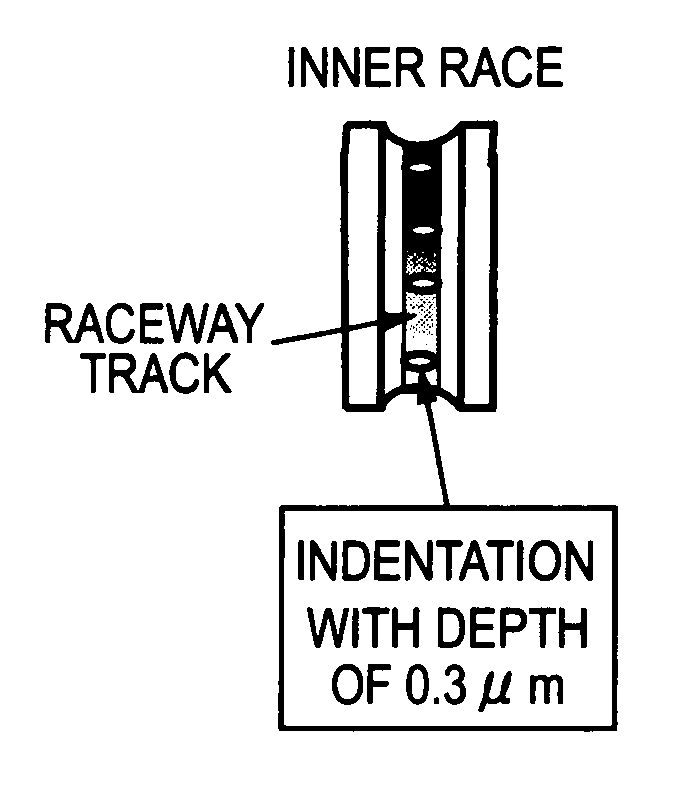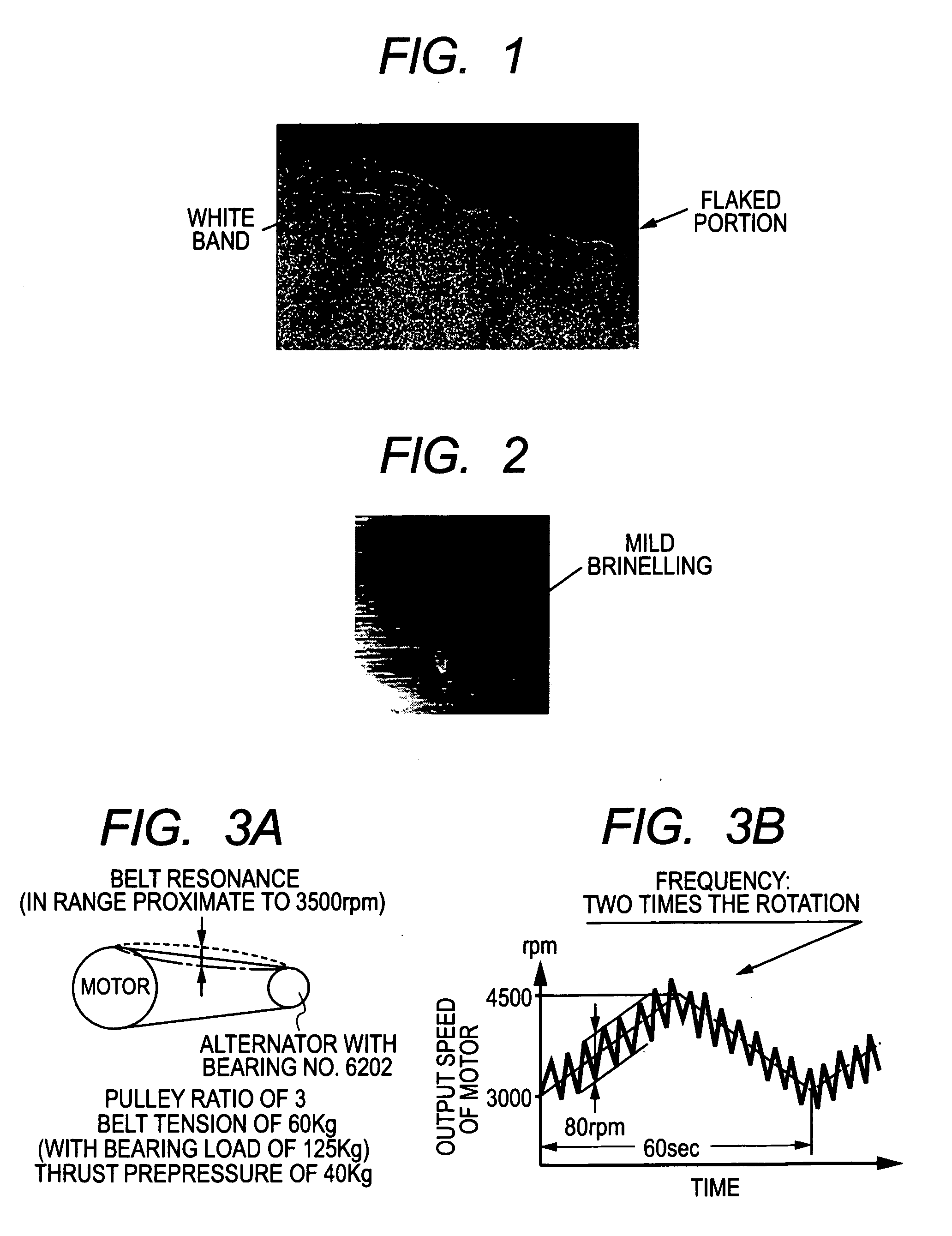Despite the bearing playing a role as an important component part, there are many probabilities in which no definite solution is obtained to clarify what is to be made to avoid such damages.
That is, with a consequence of the fatigue life, a final damage pattern results in pitching or flaking.
Moreover, when experienced with permanent deformation, the damage pattern results in
brinelling (in a
brinelling Indentation).
Despite such brinelling, the bearing suffers from, in addition to such a damage pattern, other damages in various patterns.
All of the causes for these phenomena are clarified but no distinct solution is provided for which of a threshold value of the cause results in the occurrence of damage to the bearing.
Therefore at the current status quo, it is quite difficult to make a design of a bearing in a preliminary stage to avoid such phenomenon.
This results in
exposure of flaking accompanied by variation in tissue under new patterns.
To be different from a consequence in which all of roller bearings, subjected to rolling life tests conducted on flaking based on a fatigue in the related art practice, are caused to suffer from fatigue breakdown on a final stage, no mechanism of such brittle flaking has been determined yet.
That is, this theory stands on the ground that a ball is caused to slip due to stress such as vibrations applied to the bearing in use and heat and pressure develop in the bearing to cause the
decomposition of
grease into
hydrogen with the
resultant occurrence of flaking due to
hydrogen brittleness.
However, as a result of various tests conducted by the present inventors, these attempts have not always been successful in the prevention of flaking.
Certainly, a bearing made of steel forcedly added with
hydrogen in a preceding step undergoes white-banded flaking within a short time interval during a test in most of the conditions but no conclusion was obtained in the bearing wherein
grease is decomposed into hydrogen during normal operation to cause hydrogen to penetrate into steel resulting in white-banded flaking due to hydrogen
brittleness.
As set forth above, none of the mechanisms meets actual conditions for brittle flaking to take place in new types of damage patterns and it is completely unclear to determine which of stress factors of a real
machine adversely affects on the occurrence of flaking.
With such a structure, an issue progressively arises in an increase in belt tension, belt
resonance and promoted engine vibration or the like and under such conditions bearings suffer from stress in a complicated pattern.
None of the theories, proposed in the past as mentioned above, have made solutions to the occurrence of such brittle flaking.
In
spite of the
roller bearing playing a role as the Important mechanical element component part, not only full-fledged measure had not be taken to address the issue of brittle flaking but also even the mechanism for addressing such issue had not been established.
Further, certain damage with mild brinelling has come to be found in a bearing installed on an
alternator employing a modern serpentine drive
system (see FIG. 2).
Among bearings subjected to mild brinelling, some bearings have come out to consequences wherein due to adversely affect resulting from such mild brinelling, balls of the bearings tend to be worn each in a band-like configuration to evolve into a pattern liable to be mistaken to be
grinding burn.
Although there is a common idea in that the bearing is subjected to vibration accompanied by an indentation during a transportation of an automobile on a ship or a trailer, no way exists for mild wear to take place because damage of this kind has not been recognized in bearings of the related art
belt drive system prior to the employment of a serpentine drive
system and even during a halt of an engine, belt tension has prevented the bearings from being subjected to undulation resulting from vibrations caused during transportation.
If the primary failure (In the form of mild brinelling) can be suppressed, then, no various secondary failures induced from such a primary failure take place and, therefore, a need arises to suppress the occurrence of mild brinelling but even such a mechanism has not been established in the related art.
Further, in
spite of an extremely short
operating life resulting from brittle flaking caused in a modern bearing as compared to that of a commonly experienced fatigue life (no problems had arisen in alternators in
actual practice), no mechanism for explaining such a phenomenon has been established and a situation stands with no capability of taking appropriate measure to address the issue.
With no alternatives, woefully inefficient methods in irregular measures have heretofore been taken in this status quo for each of the auxiliary units of the engines upon conducting a test of the bearing on a real
machine for confirmation.
This results in wasteful efforts involving a step of manufacturing a bearing with an unnecessary increase in size or a bearing with increased prevision.
Even with such attempts, such an inconvenience could not be completely addressed.
Also, no mechanism for the occurrence of mild brinelling in a modern bearing had been clarified in the status quo.
 Login to View More
Login to View More  Login to View More
Login to View More 


